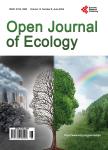Foodweb Trophic Level and Diet Inference Using an Extended Bayesian Stable Isotope Mixing Model
Foodweb Trophic Level and Diet Inference Using an Extended Bayesian Stable Isotope Mixing Model作者机构:Department of Mathematics and Statistics University of New Mexico Albuquerque NM USA Department of Earth Ocean and Atmospheric Sciences Florida State University Tallahassee FL USA
出 版 物:《Open Journal of Ecology》 (生态学期刊(英文))
年 卷 期:2022年第12卷第6期
页 面:333-359页
主 题:Stable Isotope Animal Ecology Trophic Level Animal Diet Informative Priors
摘 要:You are what you eat (diet) and where you eat (trophic level) in the food web. The relative abundance of pairs of stable isotopes of the organic elements carbon (e.g., the isotope ratio of 13C vs 12C), nitrogen, and sulfur, among others, in the tissues of a consumer reflects a weighted-average of the isotope ratios in the sources it consumes, after some corrections for the processes of digestion and assimilation. We extended a Bayesian mixing model to infer trophic positions of consumer organisms in a food web in addition to the degree to which distinct resource pools (diet sources) support consumers. The novel features in this work include: 1) trophic level estimation (vertical position in foodweb) and 2) the Bayesian exposition of a biologically realistic model [1] including stable isotope ratios and concentrations of carbon, nitrogen, and sulfur, isotopic fractionations, elemental assimilation efficiencies, as well as extensive use of prior information. We discuss issues of parameter identifiability in the complex and most realistic model. We apply our model to simulated data and to bottlenose dolphins (Tursiops truncatus) feeding on several numerically abundant fish species, which in turn feed on other fish and primary producing plants and algae present in St. George Sound, FL, USA. Finally, we discuss extensions from other work that apply to this model and three important general ecological applications. Online supplementary materials include data, OpenBUGS scripts, and simulation details.



